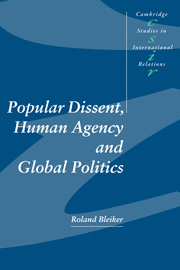Book contents
- Frontmatter
- Contents
- Acknowledgements
- Prologue: Theorising transversal dissent
- Introduction: Writing human agency after the death of God
- Part I A genealogy of popular dissent
- Part II Reading and rereading transversal struggles
- 4 From essentialist to discursive conception of power
- First interlude: Confronting incommensurability
- 5 Of ‘men’, ‘women’ and discursive domination
- 6 Of great events and what makes them great
- Part III Discursive terrains of dissent
- Conclusion: The transitional contingencies of transversal politics
- Index
- CAMBRIDGE STUDIES IN INTERNATIONAL RELATIONS
6 - Of great events and what makes them great
Published online by Cambridge University Press: 23 October 2009
- Frontmatter
- Contents
- Acknowledgements
- Prologue: Theorising transversal dissent
- Introduction: Writing human agency after the death of God
- Part I A genealogy of popular dissent
- Part II Reading and rereading transversal struggles
- 4 From essentialist to discursive conception of power
- First interlude: Confronting incommensurability
- 5 Of ‘men’, ‘women’ and discursive domination
- 6 Of great events and what makes them great
- Part III Discursive terrains of dissent
- Conclusion: The transitional contingencies of transversal politics
- Index
- CAMBRIDGE STUDIES IN INTERNATIONAL RELATIONS
Summary
Believe me, friend Hellishnoise: the greatest events – they are not our loudest but our stillest hours. Not around the inventors of new noise, but around the inventors of new values does the world revolve; it revolves inaudibly.
Admit it! Whenever your noise and smoke were gone, very little had happened. What does it matter if a town became a mummy and a statue lies in the mud? And this word I shall add for those who overthrow statues: nothing is more foolish than casting salt into the sea and statues into the mud.
More than a century after Nietzsche put these words into Zarathustra's mouth, during the summer of 1883 in Sils Maria, overthrowers not far from this Swiss mountain village still believe they have changed the world by hurling statues into the mud. Of course, the East German revolution of 1989 was spectacular. It was a key event in global politics. One of the most authoritarian regimes of East-Central Europe crumbled as people took to the streets. The scenes of common citizens climbing over and dismantling the Berlin Wall could not have been a more sensational, more symbolic termination to the Cold War. They provided perfect snap-shot pictures that satisfied the short attention span of worldwide television audiences. The corresponding sound bite, ‘we are the people’, still resonates throughout the world. But were these spectacular acts the decisive factors that caused social change? Was the overthrowing of communist statues really the key to it all?
- Type
- Chapter
- Information
- Popular Dissent, Human Agency and Global Politics , pp. 173 - 184Publisher: Cambridge University PressPrint publication year: 2000

